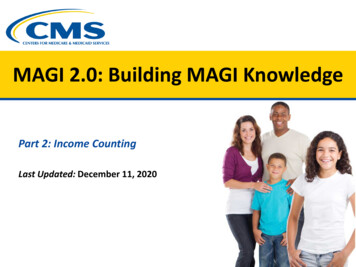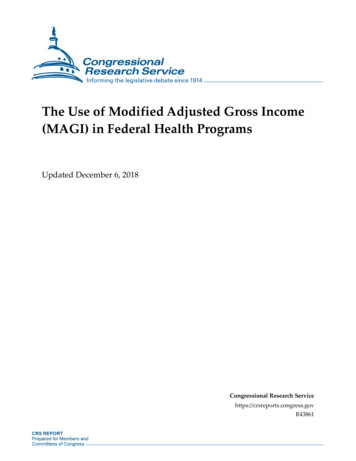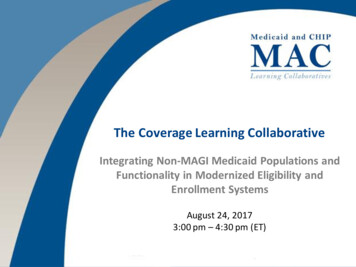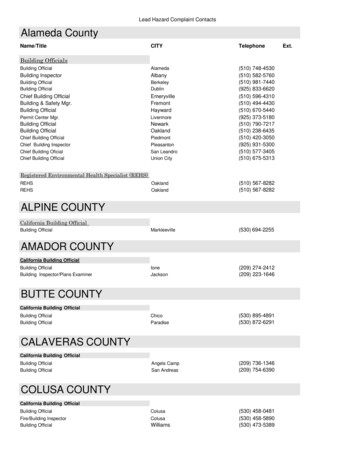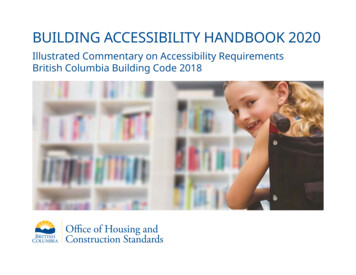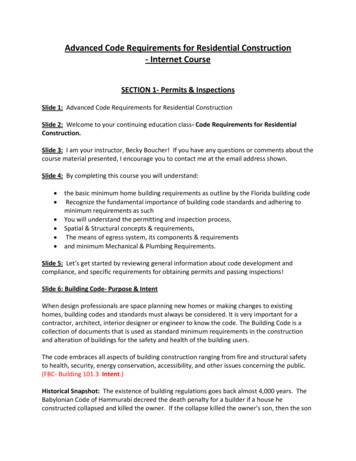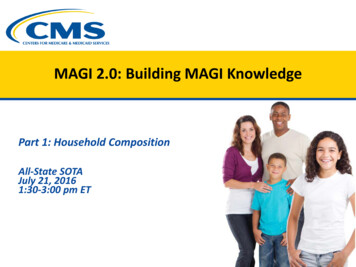
Transcription
MAGI 2.0: Building MAGI KnowledgePart 1: Household CompositionAll-State SOTAJuly 21, 20161:30-3:00 pm ET
Introduction
Setting the Stage In 2013, CMS developed a training manual to help states and eligibility workersunderstand and apply MAGI-based rules for Medicaid and CHIP. The manual is available at: ition-and-income-training.zip Today, we share a companion to the 2013 training manual, focusing on how to applyMAGI-based rules for complex households and special populations that were notpreviously covered. To identify today’s scenarios, we reviewed questions asked by states via the SPAprocess, individual technical assistance requests, SOTA and the Coverage LearningCollaborative.3
Modified Adjusted Gross Income4Modified Adjusted Gross Income (MAGI) is a methodology, based on federal tax rules, fordetermining household composition and income.MAGI-based rules are used to determine eligibility for CHIP and for most individuals in Medicaidincluding the following groups:ChildrenAdults age 19-64Parents andcaretaker relativesPregnant womenMAGI-based rules are not used to determine Medicaid eligibility for “MAGI-excepted” individuals, such as: Individuals determined eligible based on being aged, blind or disabled Medically needy individuals Populations for whom income the agency does not have to make an income determination42 CFR 435.603(a)(2) and (j)
Two-Part SOTA Call5Determining Household CompositionCalculating Household IncomeFocus of Today’s MeetingFocus of Future Meeting
Refresher on MAGI-based Household Rules
MAGI-based Household Composition7Key Questions When Applying the MAGI-based Methodology:Does the individual expect to file taxes or expect to be claimed asa tax dependent?Does the individual live together with a spouse?Does the individual meet a tax dependent exception?When an individual is not eligible for Medicaid based on MAGI, prior to determining theindividual ineligible for Medicaid, states must consider all other bases of eligibility if:(1) Potential eligibility on another basis is indicated on application or renewal, or(2) The individual requests such consideration.42 CFR 435.911(c)(2)
MAGI-based Household Composition842 CFR 435.603
Expected Tax Filing Status9Does the individual expect to file taxes orexpect to be claimed as a taxdependent?MAGI ApplicantTax Filer or TaxDependentMarried LivingTogetherYesApply Tax Filer Rules For tax filers: The individual’s householdconsists of the individual and everyone theindividual expects to claim as a tax dependent For tax dependents: The individual’shousehold is the same as the household of thetax filer claiming the individual42 CFR 435.603(f)(1) and (f)(2)NoNon-FilerTaxDependentExceptionApply Non-Filer Rules The individual’s household consists of theindividual and if living with the individual: The individual’s spouse The individual’s children* If the individual is a child*, the individual’sparents and siblings (if the sibling is achild*)*A child is an individual under age 19 and, if electedby the state, a full-time student aged 19 or 20.42 CFR 435.603(f)(3)
Married Living Together10MAGI ApplicantFor tax filers, does the individual livetogether with a spouse?Tax Filer or TaxDependentMarried LivingTogetherYesFiles Taxes & Married Livingwith SpouseIf a tax filer is married and living together with aspouse: Apply tax filer rules; and Include the spouse in the individual’shousehold regardless of whether they expectto file jointlyNoNon-FilerTaxDependentExceptionFiles Taxes & Married ButNot Living with Spouse For separated spouses filing jointly: Apply taxfiler rules and include the spouse in theindividual’s household. For separated spouses filing separately: Applytax filer rules and do not include the spouse inthe individual’s household.We will return to this scenario laterin the slide deck!42 CFR 435.603(f)(4)42 CFR 435.603(f)(1)
Tax Dependent Exception11MAGI ApplicantDoes the individual meet a taxdependent exception?Tax Filer or TaxDependentMarried LivingTogetherYesNoTax Dependent ExceptionIf the individual: Expects to be claimed as a tax dependent by someone other than aparent; or Is a child* who lives with two parents and expects to be claimed as a taxdependent by one parent, but the parents (married or unmarried) donot expect to file jointly; or Is a child* who lives with a parent, but expects to be claimed as a taxdependent by a non-custodial parent, thenUse non-filer rules to determine the household of the tax dependent.*A child is an individual under age 19 and, if elected by the state, afull-time student aged 19 or 20.42 CFR 435.603(f)(2)(i),(f)(2)(ii) and (f)(2)(iii)NonFilerTaxDependentExceptionNo Exception Apply tax filer rules
Application of Tax Dependency Rules in Medicaid and CHIPQuestion 12QuestionAre Medicaid and CHIP agencies required to determine whether a tax filer may claim another individual as a taxdependent?StateAnswer No, Medicaid and CHIP agencies are not obligated to determine whether an individual may be claimed asa tax dependent. Agencies may accept self-attestation of tax dependent status. The agency may request additional information if attested information appears inconsistent with tax filingrules. For example, if a tax filer expects to claim another individual with more income than the tax filer,the state may inquire further. Medicaid and CHIP agencies do not determine whether an individual may claim another individual as a taxdependent. In instances when tax dependency cannot be reasonably established, under 42 CFR 435.603(f)(5), theinclusion of such individual in the household is determined in accordance with the non-filer rules.CMS is available to provide technical assistance.
A Look at Scenarios for ComplexHouseholds & Special Populations
Complex Households & Special Populations:ScenariosInstitutionalized ChildrenVictims of Intimate Partner ViolenceJoint CustodyChild Tax Filer Living with ParentHomeless YouthSeparated Spouses Filing Jointly14
Institutionalized Children
Institutionalized Children16Current Regulations Current rules for tax dependents donot include an exception forchildren living in an institution.Relevant Regulatory Language:42 CFR 435.603(f)(2)Basic rule for individuals claimed as a tax dependent. In the case ofan individual who expects to be claimed as a tax dependent thehousehold is the household of the tax filer claiming such individual asa tax dependent, except that the household must be determined inaccordance with paragraph (f)(3) of this section in the case of [a taxdependent exception].42 CFR 435.603(f)(3)Rules for individuals who neither file a tax return nor are claimed as atax dependent. In the case of individuals who do not expect to file aFederal tax return and do not expect to be claimed as a taxdependent the household consists of the individual and, if livingwith the individual
Institutionalized Children:MAGI Determination17Scenario: Susan and Bob are married and expect to file jointly. They have a son, Ben (age 10), whois living in an institution.Question: Who is counted in Ben’s household? There are a number of factors to consider when determining whether or not to claim someone as a tax dependent, includingtax benefits. It is not under the purview of the state Medicaid agency to advise applicants on how to file their taxes. If Ben is claimed as a tax dependent and is not eligible for MAGI Medicaid due to his parents’ income, Ben may be eligible ona non-MAGI basis depending on the optional eligibility categories covered under the state plan.
Institutionalized Children:Non-MAGI Determination18States can provide Medicaid coverage to a disabled child – regardless of the parents’ incomeand resources – after that child has spent 30 consecutive days in the hospital.Most states already do so.Institutionalized Children Eligible under the Special Income Level CategoryStates may adopt the special income level category, which serves individuals who: Have been institutionalized for at least 30 days, Meet the resource requirements for the most closely related cash assistance program, and Have gross income below 300% of the Supplemental Security Income (SSI) federal benefit rate.States may, if they have not already done so, include as a covered group within this category children whoare under the age of 18, 19, 20 or 21 (at state option).For this category, eligibility is determined on a non-MAGI basis and parents’ income and resources are notcounted.SSA 1902(a)(10)(A)(ii)(V); SSA 1905(a)(i)
Victims of Intimate Partner Violence
Victims of Intimate Partner Violence20Current Regulations Current rules do notinclude an exception forvictims of intimatepartner violence.Relevant Regulatory Language:42 CFR 435.603(f)(1)Household – Basic rule for taxpayers not claimed as a tax dependent. In the case ofan individual who expects to file a tax return for the taxable year in which an initialdetermination or renewal of eligibility is being made, and who does not expect tobe claimed as a tax dependent by another taxpayer, the household consists of thetaxpayer and all persons whom such individual expects to claim as a taxdependent.42 CFR 435.603(f)(3)Rules for individuals who neither file a tax return nor are claimed as a taxdependent. In the case of individuals who do not expect to file a Federal tax returnand do not expect to be claimed as a tax dependent the household consists ofthe individual and, if living with the individual
Victims of Intimate Partner Violence21Discussion For victims of intimate partner violence, contacting an abusive spouse to file jointly or obtaininformation for a MAGI determination may pose safety and/or legal concerns. Absent information to the contrary, it is reasonable to expect that a victim of intimate partnerviolence will either file separately from the spouse or will not file, depending on thecircumstance. In either case, the abusive spouse will not be included in the victim’s householdbecause they do not expect to file jointly.Reasonably Predictable Changes in Income Option:Even if the victim of intimate partner violence expects to file jointly during the current tax year, the individual’s taxfiling status may change in the upcoming year. If the individual indicates that it will change, CMS has determinedthat states can use the “reasonably predictable changes in income” option, consistent with 42 CFR 435.603(h)(3), tonot include the abusive spouse in the victim’s household.
Victim of Intimate Partner Violence:Single IndividualScenario: Shannon is a victim of intimate partner violence and no longer lives with her husband.Shannon does not expect to file jointly with her husband.Question: Who is counted in Shannon’s household?22
Victim of Intimate Partner Violence:Parent23Scenario: Jasmine and her husband have three (3) children. Jasmine is a victim of intimate partnerviolence. She and her children are currently living in an emergency shelter. Jasmine is unsure howshe expects to file and who will claim the children.Question: Who is counted in Jasmine’s household? “In most cases a child of divorced or separated parents is the qualifying child of the custodial parent.” IRS Publication 504 To the extent it is a transitional situation with uncertainty, the reasonable approach is to apply the non-filer rules. Under nonfiler rules, the children are counted in the household of the parent with whom they are living.
Joint Custody
Joint Custody25Current Regulations In joint custody scenarios, it may be unclearwho the “custodial” and “non-custodial” parentis, and which parent the child is “living with.” These are important distinctions when applyingMAGI rules: Tax dependents claimed by the parentidentified as “non-custodial” meet a taxdependent exception. When the non-filer rules are applied, thechild’s household includes the parent whois “living with” the child.Relevant Regulatory Language:42 CFR 435.603(f)(2)(iii)The household must be determined in accordance withparagraph (f)(3) of this section in the case of [a child] whoexpects to be claimed as a tax dependent by a noncustodial parent. For purposes of this section—(A) A court order or binding separation, divorce, or custodyagreement establishing physical custody controls; or(B) If there is no such order or agreement or in the event ofa shared custody agreement, the custodial parent is theparent with whom the child spends most nights.42 CFR 435.603(f)(3)Rules for individuals who neither file a tax return nor areclaimed as a tax dependent. In the case of individuals whodo not expect to file a Federal tax return and do not expectto be claimed as a tax dependent the household consistsof the individual and, if living with the individual
Joint Custody26Discussion Utilizing information available on the single streamlined application, it is reasonable to treat the parentapplying for health coverage for the child as the custodial parent, absent any information to indicate thatthe parent is non-custodial. In cases when there is a discrepancy (e.g., both parents are applying separately for health coverage forthe same child in the same year), the custodial parent is the parent with whom the child spends mostnights, as described at 42 CFR 435.603(f)(2)(iii)(B). Because current regulations do not explicitly address situations where the child spends an equal numberof nights with both parents, states have the flexibility to establish a reasonable approach, which must beapplied uniformly to known joint custody cases. Examples may include: The custodial parent is the parent who claims the child as a tax dependent The custodial parent is the parent with higher income The custodial parent is the parent with lower income* The flexibility described on this slide applies only for purposes of the MAGI-based methodology; different rules may apply for otherMedicaid/CHIP eligibility purposes, such as eligibility for the parent/caretaker relative group.
Joint Custody:ScenarioScenario: Bryan is 8 years old. Bryan’s parents are divorced and share equal custody of Bryan. Bryan spendsequal time with both parents (50/50). Bryan’s father and mother both apply for Medicaid on behalf of Bryan.Bryan expects to be claimed as a tax dependent by his father.Question: Who is counted in Bryan’s household?Example of a Reasonable Application of the RulesState policy: the parent expecting to claim a child as a tax dependent is considered the custodial parent whenthe child spends equal nights with both parents27
Child Tax Filer Living with Parent
Child Tax Filer Living with Parent29Current Regulations Current rules refer to individual taxpayers, anddo not differentiate between child and adulttaxpayers.Relevant Regulatory Language:42 CFR 435.603(f)(1)Household – Basic rule for taxpayers not claimed as a taxdependent. In the case of an individual who expects tofile a tax return for the taxable year in which an initialdetermination or renewal of eligibility is being made, andwho does not expect to be claimed as a tax dependentby another taxpayer, the household consists of thetaxpayer and all persons whom such individual expectsto claim as a tax dependent.
Child Tax Filer Living with Parent30Current Regulations, cont. Scenariosaddressed incurrentregulations:Child living with a parent;the child Files Tax ReturnIs Claimed as TaxDependent by ParentIs Not Claimed as TaxDependent by ParentClear Rules:Parent included in thechild’s household42 CFR 435.603(f)(2)Does Not File Tax ReturnClear Rules:Parent included in thechild’s household42 CFR 435.603(f)(2)Current rules do not explicitlyaddress this scenarioClear Rules:Parent included in the child’shousehold (i.e., non-filer rules)42 CFR 435.603(f)(3)Discussion The intent was to align Medicaid/CHIP rules with Marketplacerules. Thus, parents living with a child are included in the child’shousehold, regardless of the child’s tax filing status. Due to an oversight in drafting, this clarification was not includedin the regulation text. Although states can interpret the regulatory language literally, theyhave flexibility to always count the parent(s) living with a child inthe child’s household.FFM Practice The FFM includes the parent(s)living with a child in the child’shousehold.
Child Tax Filer Living with Parent:Parent’s Household (Susan)Scenario: Alex is a child (age 17) and expects to file taxes. Alex lives with her mother, Susan, who does notexpect to claim her as a tax dependent.Question: Who is counted in Susan’s and Alex’s households?31
Child Tax Filer Living with Parent:Child’s Household (Alex)32Scenario: Alex is a child (age 17) and expects to file taxes. Alex lives with her mother, Susan, who does notexpect to claim her as a tax dependent.Question: Who is counted in Susan’s and Alex’s households? Situation may occur when there is a working teen living with non-working parent and in farm families.States have flexibility to always include Susan in Alex’s household, even if Alex is not claimed as a tax dependent, because Alexis a child living with her parent.States have flexibility with respect to the approach that they choose. However, states need to take the same policy approachin all scenarios (i.e., states need to choose one approach or the other).
Homeless Youth
Homeless Youth34Current Regulations Current rules do notexplicitly addresshomeless youth.Relevant Regulatory Language:42 CFR 435.603(f)(2)Basic rule for individuals claimed as a tax dependent. In the case of an individualwho expects to be claimed as a tax dependent the household is the household ofthe taxpayer claiming such individual as a tax dependent, except that thehousehold must be determined in accordance with paragraph (f)(3) of this sectionin the case of [a tax dependent exception].42 CFR 435.603(f)(3)Rules for individuals who neither file a tax return nor are claimed as a taxdependent. In the case of individuals who do not expect to file a Federal tax returnand do not expect to be claimed as a tax dependent the household consists ofthe individual and, if living with the individual
Homeless Youth35Discussion For homeless youth, obtaining the information needed for a MAGI determination may be challenging. When applying for Medicaid, the homeless youth determines and communicates his/her expected taxfiling status. It is reasonable to expect that parents of homeless youth may not be providing support for them orclaiming them as tax dependents. From the youth’s perspective, he/she will not be claimed as a taxdependent by his/her parent.Reasonably Predictable Changes in Income Option:Even if the homeless youth expects to be claimed as a tax dependent during the current tax year, the individual’stax filing status may change in the upcoming year. If the individual indicates that it will change, CMS hasdetermined that states can use the “reasonably predictable changes in income” option, consistent with 42 CFR435.603(h)(3), to not include the parent(s) in the homeless youth’s household.
Homeless Youth:ScenarioScenario: Mark (age 16) is homeless and no longer lives with his parents.Question: Who is counted in Mark’s household?36
Separated Spouses Filing Jointly
Separated Spouses Filing Jointly38Current Regulations Current rules refer to: Individual taxpayers, and Married couples livingtogether. Currents rules do not referencejoint filers who are not livingtogether.Relevant Regulatory Language:42 CFR 435.603(f)(1)Household – Basic rule for taxpayers not claimed as a tax dependent. In thecase of an individual who expects to file a tax return for the taxable year inwhich an initial determination or renewal of eligibility is being made, and whodoes not expect to be claimed as a tax dependent by another taxpayer, thehousehold consists of the taxpayer and all persons whom such individualexpects to claim as a tax dependent.42 CFR 435.603(f)(4)Household – Married couples. In the case of a married couple living together,each spouse will be included in the household of the other spouse, regardlessof whether they expect to file a joint tax return
Separated Spouses Filing Jointly39Current Regulations, cont. Scenarios addressed in current regulations:Married FilingJointlyLiving TogetherClear Rules:Spouses count in eachother’s householdsNot Living TogetherCurrent rules do not explicitlyaddress this scenario42 CFR 435.603(f)(4)FilingSeparatelyClear Rules:Spouses count in eachother’s households42 CFR 435.603(f)(4)Clear Rules:Spouses do not count ineach other’s households42 CFR 435.603(f)(1)
Separated Spouses Filing Jointly40Discussion The intent behind the final regulation published in March 2012 was to align Medicaid/CHIP rules with theMarketplace rules. Thus, if a married couple expects to file jointly, the intent was that spouses are included in each other’shouseholds, regardless of whether they live together and regardless of the reason for their separation(including incarceration or institutionalization). Because current regulations do not explicitly address this exact issue, states have the flexibility to use adifferent approach, in which spouses are only included in each other’s households if they live together,which is consistent with traditional Medicaid rules. Though not required, states may want to convey their choiceto CMS, especially if they count spouses together only whenliving together, and have it affirmed by CMS for purposes ofPERM audits.Federally-facilitated Marketplace(FFM) Practice The FFM always counts joint taxfilers in each other’shouseholds.
Separated Spouses Filing Jointly:Scenario 1 – Incarcerated Spouse41Scenario: Tim and Tina are married and they have two children together. Tim was recentlyincarcerated. Tina lives with the two children. Tim and Tina expect to file taxes jointly and claimtheir children as tax dependents.Question: Who is counted in Tim’s household? States have flexibility with respect to the approach that they choose. However, states need to take the same policy approachfor all scenarios (i.e., states need to choose one approach or the other for all spouses married filing jointly).
Separated Spouses Filing Jointly:Scenario 2 – Institutionalized Spouse42Scenario: Katie and Charles are married and they expect to file taxes jointly. Katie is living in aninstitution.Question: Who is counted in Katie’s household? States have flexibility with respect to the approach that they choose. However, states need to take the same policy approachfor all scenarios (i.e., states need to choose one approach or the other for all spouses married filing jointly).
Separated Spouses Filing Jointly:Additional ConsiderationAdditional Consideration: Eligibility Category of the Separated Spouse4342 CFR 435.4, 435.110 While spouses and children living apart may be included in the same MAGI household, different rules may apply forother Medicaid/CHIP eligibility purposes. For instance, a parent who is not living with a child cannot qualify for Medicaid as a parent/caretaker relative. In order to be considered under the Medicaid parent/caretaker relative eligibility category, the individual must: Be a relative* of a dependent child by blood, adoption or marriage, and Be living with the child, and Assume primary responsibility for the child's care (as may, but is not required to, be indicated by claiming thechild as a tax dependent for Federal income tax purposes). Incarcerated and institutionalized parents cannot be eligible as a parent/caretaker relative under 42 CFR 435.110.*This relative must be a child’s father, mother, grandfather, grandmother, brother, sister, stepfather, stepmother, stepbrother, stepsister, uncle,aunt, first cousin, nephew, or niece; spouse of such parent or relative, including after marriage is terminated by death or divorce; or, otherindividuals a state may specify.
Discussion
Questions & Discussion45
Part 2: Household IncomeCalculating Household IncomeFocus of Future Meeting46
MAGI 2.0: Building MAGI Knowledge. Part 1: Household Composition. All-State SOTA. July 21, 2016 . 1:30-3:00 pm ET. Introduction. Setting the Stage. 3 . Key Questions When Applying the MAGI- based Methodology: Does the individual expect to file taxes or expect to be claimed as a tax dependent?
